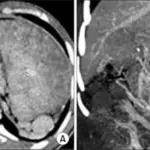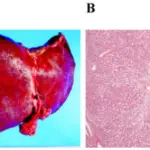Portal Vein Thrombosis is the blockage or narrowing of the portal vein by a blood clot
What is the Pathology of Portal Vein Thrombosis?
The pathology of portal vein thrombosis is:
-Etiology: The cause of portal vein thrombosis is prothrombotic disorders, tumor thrombus, cirrhosis, pancreatitis, various infections
-Genes involved: None.
-Pathogenesis: The sequence of events that lead to portal vein thrombosis includes hepatic artery buffer response allows for increased arterial flow to the liver when the portal vein is obstructed.
-Histology: The histology associated with portal vein thrombosis shows no bridging fibrosis, can mimic cirrhosis.
How does Portal Vein Thrombosis Present?
Patients with portal vein thrombosis typically affect males present in the age range of 35-55. The symptoms, features, and clinical findings associated with portal vein thrombosis include abdominal pain, ascites (massive, intractable), portal hypertension, and bowel infarction.
How is Portal Vein Thrombosis Diagnosed?
Portal vein thrombosis is diagnosed via CT scan.
How is Portal Vein Thrombosis Treated?
Portal vein thrombosis is treated with anticoagulation medicine if caused by acute portal vein thrombosis.
What is the Prognosis of Portal Vein Thrombosis?
The prognosis of portal vein thrombosis is fair depending upon the cause.



